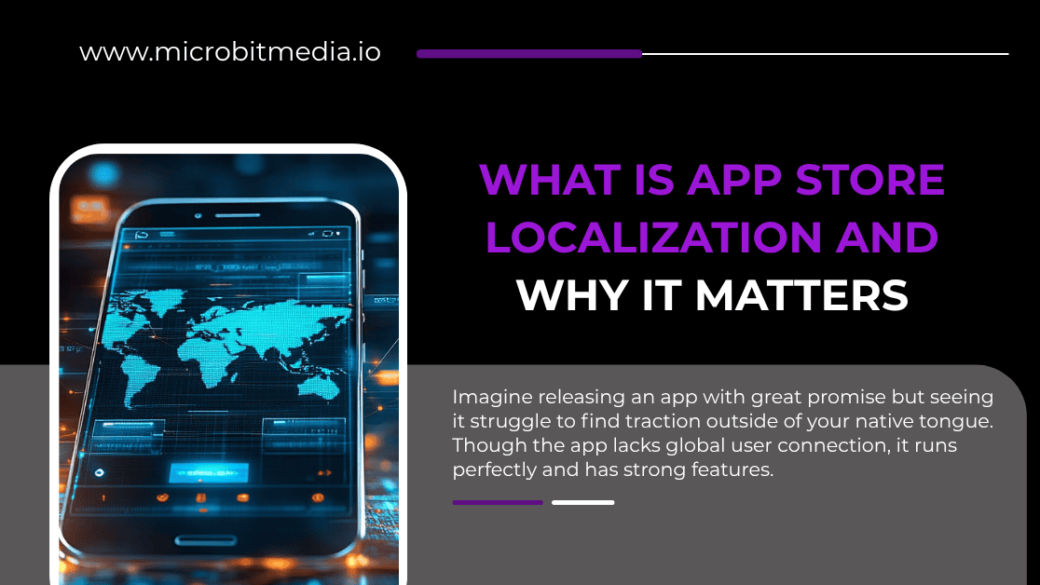Imagine releasing an App Store Localization with great promise but seeing it struggle to find traction outside of your native tongue. Though the app lacks global user connection, it runs perfectly and has strong features. What then? Usually, the presentation of the app determines the answer rather than its actual nature. This is where localization of app stores becomes extremely important.
Knowledge of App Store Localization
Fundamentally, app store localization is the process of customizing the presence of your app in particular areas and languages in app stores like Google Play and Apple’s App Store. This is a calculated attempt to make your app feel natural to local users, so improving discoverability and download capacity.
Localization entails:
- Converting text into native language.
- Changing keywords to represent local search behaviour.
- Changing screenshots and graphics to appeal culturally.
- Making sure local quirks match app titles, descriptions, and metadata.
Such careful adaptation closes the distance between your product and different user expectations all around.
The Value of App Store Localization
1. Enhancement of Organic Visibility
Because users search in their own tongue, localized content is favored by search algorithms housed in app stores. Your app runs great risk of being invisible in local search results without localization, so severely restricting natural reach. Effective localization targets local keywords, increasing the likelihood that users looking for answers in their native tongue will find your app.
2. Improved Trust and User Engagement
Apps that feel familiar and culturally relevant let users interact more easily. A well-localized app store listing lowers ambiguity, builds trust, and drives downloads. Conversion rates can be greatly influenced by this first impression, transforming casual browsers into devoted consumers.
3. Competitive Edge in Markets Still Under saturation
Localization helps your app stand out among millions of apps vying for users by separating it from rivals with merely generic, translocated listings. This benefit is particularly important in markets where local tastes significantly affect app use and purchase choices.
4. Enhanced Monetization and Retention
Localization affects user interaction with your app after install, not only downloads. Localized marketing materials clearly define expectations, so lowering attrition and raising the possibility of in-app purchases or subscriptions fit local economic reality.

Best Practices for Localized App Store Effectiveness
Think about the following to best leverage localization:
Use Professional Localization: Services to steer clear of automatically translated materials that might overlook cultural nuances or context.
Research Local Keywords: Find and combine keywords local users actually search for.
Use Professional Localization: Customize screenshots and promotional videos to mirror local settings and tastes.
Test Localized Version: A/B testing local audiences will help you to improve visuals and messaging.
Markets Change: Thus, always evaluate performance and update localization components in line with these changes.
Translation vs Localization: The Difference
One should be clear in differentiating between basic app store localization and simple translation. Translation turns text from one language into another only. Localization, however, adjusts material to fit cultural, regional, and even financial settings. This covers idioms, measuring units, date forms, and culturally relevant images.
Colours, for instance, have different connotations in different cultures; red marks luck in some but warns others. Screenshots or icons from an app that appeal in one nation could be perplexing or embarrassing in another. Localization is a more all-incapable and successful tactic than translation by itself because of this cultural sensitivity.
The Impact of Localization on App Store Rankings
App stores operate complex algorithms that determine which apps appear at the top of search results. Keywords play a huge role, but so do user engagement signals like downloads, ratings, and reviews. Localization improves all these signals by:
- Capturing local keyword traffic that generic listings miss
- Increasing user downloads and installs through relevant messaging
- Boosting positive reviews when users feel the app speaks their language
- Lowering uninstalls rates by setting accurate expectations upfront
These factors combined enhance your app’s organic ranking, driving sustained growth without escalating advertising spend.
Selecting which markets to localize for
Every market demands different degrees of localization investment. Sort depending on:
- Countries with high rates of mobile and app: Adoption present more market possibilities based on their size.
- Competitive Landscape: Target markets where localization will provide you a notable advantage based on competitive landscapes.
- Existing user interest: Review your present user data to find naturally occurring market trends.
- Language barriers: Markets where English or the original language of your app is not generally spoken often benefit most.
This focused approach guarantees that rather than distributing resources too thinly, your localization efforts maximize return on investment.
App Store Localization from the Technical Perspective
Beyond metadata, think on app content itself:
- UI and UX: Localize buttons, menus, error messages, in-app text, UI and UX.
- Legal and compliance: Change terms, disclaimers, privacy policies, to fit local laws and regulations.
- Payment Options: Support regionally preferred currencies and payment systems.
- Customer Support: Provide localised FAQs and help centres as well as, where at all possible native-language support.
These tweaks support a flawless user experience that fits your efforts at app store localization.

Success Stories from the Real World
Applications that have embraced localization show quite amazing outcomes. For example, following localized app store listings, some worldwide social sites raised downloads by more than 50% in new markets. Financial apps saw user retention rise as they matched tutorials and descriptions to local rules and degrees of financial literacy.
These achievements highlight a fundamental truth: localization is a fundamental development tool not a marketing afterthought.
Localization Is a Constant Process
Localizing cannot be done “set it and forget it.” Markets change; languages change; user expectations change. Constant updating of localized material helps your app remain competitive and relevant.
Analytics lets you see which localized versions work best and point up areas needing improvement. Maintaining proactive localization guarantees that your app stays in close touch with your users all around.
Evaluating the Benefits of App Store Localization
App store localization makes your app from a generic good locally relevant. It builds trust, improves discoverability, raises user involvement, and finally drives downloads and income.
Companies who make careful, culturally sensitive localization investments position themselves for long-term success in the worldwide market.
Localization’s Part in Reducing User Acquisition Costs
The effect on user acquisition cost (UAC) of app store localization is among the less clear but significant advantages. More people turn into downloads when your app store listing speaks to local users via language and culture, reducing the need for additional advertising expenditure.
Greater organic installs from localized material mean less dependence on expensive paid campaigns. Localization is a wise investment for sustainable scaling since over time this efficiency releases money for other development projects like feature building or customer support.
Cultural Nuances Affect User Expectations
Deeply entwined with cultural settings are personal preferences. Localization handles these subtleties by changing not only language but also tone, images, even user interface expectations.
For instance, some societies value thorough narratives and explanations while others want simple, direct messaging. Payment methods also differ; some nations let consumers choose one-time purchases over subscriptions or mobile wallets over credit cards.
Users feel appreciated and understood when in-app content and app store listings mirror these tastes. Better reviews, greater retention, and an expanding community of devoted consumers follow from this emotional connection.
Challenges of Localization and Strategies for Overcoming Them
Although localization can be challenging even if the advantages are obvious. Obstacles include:
- Keeping consistency: Across languages means that the brand voice stays whole without losing cultural relevance.
- Managing translation: Resources while prioritizing languages depending on market potential helps one to handle several languages concurrently.
- Managing app updates: Metadata changes, and compliance across many sites and stores requires technical integration.
- Maintaining speed in markets undergoing rapid change: Local trends, slang, and rules change fast and call for constant updating.
Overcoming these calls for a well-organized approach combining native language experts, use of localization management systems, and ongoing user feedback monitoring.
Evaluating Your Localization Attempts’ Performance
Track these key performance indicators (KPIs) to guarantee your localization adds value:
- Download rates per localized market: Examine development in areas where localization was applied against those without.
- Conversion rates on app pages: Track how many times users download your app following localized content on app store pages.
- User engagement metrics: Track session length, retention rates, and in-app purchases from geographically specific areas to gauge user involvement.
- User review and ratings: Analyse comments trends to find cultural acceptance and satisfaction in user reviews and ratings.
- Organic keyword ranks: Look for localized keyword visibility enhancements.
Reviewing these KPIs on a regular basis helps you to better target localization initiatives and spot fresh optimization potential.
Conclusion
App store localization is a strategic need for everyone looking for sustainable worldwide development, not a luxury reserved for multinational behemoths. Customizing the store presence of your app to fit local consumers opens new markets, improves user experience, and stimulates company success.
The issue now is not whether you should localize your app but rather how deeply you are ready to commit to really interacting with users anywhere.
Frequently Asked Questions
Why is app store localization important?
It boosts app discoverability, increases organic downloads, and enhances user trust by speaking their native language.
Which elements should be localized in the app store?
You should localize the app title, description, keywords, screenshots, and promotional videos for each target market.
How does localization impact ASO (App Store Optimization)?
Localization improves keyword relevance in local search results, increasing app ranking and downloads in specific regions.
What's the difference between translation and localization?
Translation converts text word-for-word; localization adapts the content culturally and contextually for local audiences.

